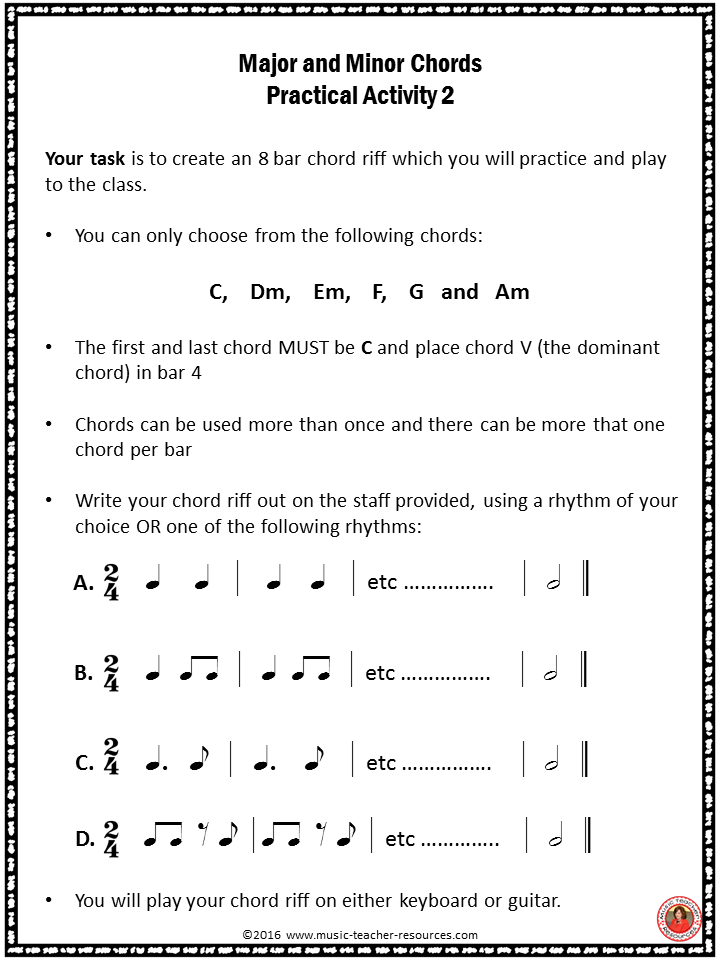Chord Progressions and the General Music Class

So, you have a general music class!
What do you plan to do with them?
How will you keep them engaged during lessons?
These are just some of the questions I asked myself when I started teaching general music classes. Teaching general classes is not easy! It wouldn't be too far from the truth to say that about 85-90% of the students in these classes have no formal music training. At best, students have taught themselves a basic riff, 3 – 4 chords on the guitar, or a piece on the keyboard, via YouTube.
Musicians would not dispute that the biggest joy comes from playing music. As music teachers, we want to introduce our students to the joy of playing music as soon as possible.
So, how can we take our students from zero/limited theory knowledge to creating and playing their own short pieces in around 3 – 4 weeks? Chord progressions are one way!
One solution is to quickly cover the bare essentials of theory and teach the students how to build major and minor chords as soon as possible.
The music concept path I take looks like this:
- Basic rhythms in simple time
- Treble lines and spaces
- Sharps, flats and naturals
- Whole steps/tones and half steps/semitones
- Building major and minor chords – on the staff, using whole steps/tones and half steps/semitones
- A practical activity creating an 8 bar chord riff which they notate on the staff, rehearse and perform to the class…..
Here are the two pages I give to the students to complete the chord progressions task.
The activity takes me two one-hour lessons to complete.
LESSON OVERVIEW
Lesson 1 is creating the chord progress and beginning to rehearse it.
Lesson 2 is rehearsing their chord progression and performing it for the rest of the class.
Before each performance, ask the student to write their chord progression on the board for the class to see and follow as it's performed.
As well as the students creating and performing, this activity also helps them realize they can create MANY different chord progressions from the same seven chords. (For this activity, they can use all the diatonic chords of C major, except for B diminished)
Students realize that no matter what chords they choose or what order they put them in (as long as they start and end with the tonic chord), the chord progression works – sounds good! Explain to them that the reason for this is that all the chords used in the progression come from the SAME key. This opens the door to introducing scales and keys. Due to completing this activity, students are interested to know how it all works.
It is essential to arrive at this point without mentioning keys, scales or key signatures! These words would confuse students and be too difficult to grasp after only 3-4 weeks.
As a result of completing this activity, the students are proud of themselves and their accomplishments. And more importantly, a whole new world of playing and melody/songwriting has opened up to them!
You can download a copy of the chord progression activity sheets by clicking the button below!
Looking for more time-saving, engaging resources?
Check out MTR’s collection of music teaching materials - SHOP the MTR Store or our store on TpT.
Would you like more music teaching strategies? Check out these related posts to keep your lessons fresh and interactive!
Blog Post: Teaching Rhythm in Music
Blog Post: 5 Call-and-Response ActivitiesTo Keep Your Music Class Engaged
Blog Post: Benefits of Body Percussion Activities
Blog Post: Energize Your Music Classroom With a Fun Rhythm Reading Game
Blog Post: Teaching Music Notation: Fun and Effective Strategies
Blog Post: Giant Staff Jumping Game: Easy Adaptations for Every Grade Level
Blog Post: Benefits of Color-by-Music Activities
Blog Post: 11 Proven Strategies to Keep Students Engaged During Music Rehearsals
Blog Post: Planning a Successful Lesson
MTR 12-Month Memberships
Save time and inspire your students with a growing collection of music-teaching resources!
Subscribe to one of the MTR 12-Month Memberships for Music Teachers today.
Click HERE for more information!
Sign up to receive the monthly MTR newsletter and gain exclusive access to the
FREE Resource Library for music teachers!




